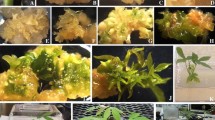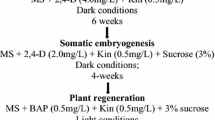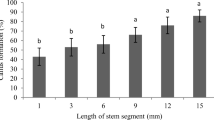Abstract
An efficient and reproducible plant regeneration system, initiated in somatic tissues, has been devised for cassava (Manihot esculenta Crantz). Somatic embryogenesis has been induced from shoot tips and immature leaves of in vitro shoot cultures of 15 cassava genotypes. Somatic embryos developed directly on the explants when cultured on a medium containing 4–16 mg/l 2,4-D. Differences were observed with respect to the embryogenic capacity of the explants of different varieties. Secondary embryogenesis has been induced by subculture on solid or liquid induction medium. Long term cultures were established and maintained for up to 18 months by repeated subculture of the proliferating somatic embryos. Plantlets developed from primary and secondary embryos in the presence of 0.1 mg/l BAP, 1mg/l GA3, and 0.01 mg/l 2,4-D. Regenerated plants were transferred to the field, and were grown to maturity.
Similar content being viewed by others
References
Ammirato PV (1983). In: DA Evans, WE Sharp, PV Ammirato, Y Yamada (eds.), Handbook of Plant Cell Culture Vol 1, MacMillan Publishing Company, New York, pp. 82–123.
Brown DCW, Atanassov A (1985) Plant Cell Tissue Organ Culture 4: 111–122.
FAO (1979) Agriculture Commodity Projections 1975–1985. Food and Agricultural Organization of the United Nations. Rome.
Haydu Z, Vasil IK (1981) Theor.Appl.Genet. 59: 269–273.
Kartha KK, Gamborg OL, Constabel F, Shyluk JP (1974) Plant Sci. Lett. 2: 107–113.
Luna LG (1968) Manual of Histologic Staining Methods of the Armed Forces Institute of Pathology. McGraw Hill Book Company, New York, p.32.
Murashige T, Skoog F (1962) Physiol. Plant. 15: 473–497.
Roca WM. (1984) In: WR Sharp, DA Evans, PV Ammirato, Y Yamada (eds.), Handbook of Plant Cell Culture vol. 2, MacMillan Publishing Company, New York, pp. 269–301.
Shahin EA and Shepard JF (1980) Plant Sci. Lett. 17: 459–465.
Stamp JA and Henshaw GG (1982) Z. Pflanzenphysiol. 105: 183–187.
Stamp JA and Henshaw GG (1986) In: LA Withers, PG Anderson (eds.) Plant Tissue Culture and its Agricultural Applications, pp. 149–157.
Stamp JA (1984) Ph.D. thesis, University of Birmingham U.K., 1984.
Tilquin JP (1979) Can.J.Bot. 57: 1761–1763.
Vasil IK (1982) In: IK Vasil, WR Scowcroft, KJ Frey (eds.) Plant Improvement and Somatic Cell Genetics, Academic Press, New York, p.179–204.
Author information
Authors and Affiliations
Additional information
Communicated by G.C. Phillips
Rights and permissions
About this article
Cite this article
Szabados, L., Hoyos, R. & Roca, W. In vitro somatic embryogenesis and plant regeneration of cassava. Plant Cell Reports 6, 248–251 (1987). https://doi.org/10.1007/BF00268492
Received:
Revised:
Issue Date:
DOI: https://doi.org/10.1007/BF00268492




